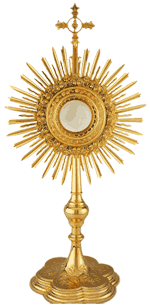Blessed John XXIII and Blessed John Paul II are to be canonized today, the Feast of Divine Mercy, in a ceremony at the Basilica of St. Peter in Rome presided over by Pope Francis. Of the 264 deceased Popes, 80 have been declared to be saints. While this might seem like a large percentage, we have to remember that 52 out of the first 54 Popes were canonized, so that only leaves 18 more out of the next 210! The odds have gotten harder after the Church left the ages of martyrdom and persecution. The last Pope canonized was Pope St Pius X on May 29, 1954, and that event was so important that a large mural of the new Pope Saint was added to the inside of St. Stephen Church to memorialize the occasion. I think three aspects of the first “joint Pope canonization” in history bear noticing.
First, Blessed John XXIII and Blessed John Paul II represent the “bookends” of the Second Vatican Council. Pope John XXIII called the council on January 25, 1959, and Pope John Paul II was present as a young auxiliary bishop from Krakow. Although Pope Paul VI and Pope John Paul I intervened between the two future saints, it was during the nearly 28 years of the pontificate of John Paul II that many of the reforms called for during the Second Vatican Council were implemented. In fact, when the Code of Canon Law was passed in 1983, Pope Jon Paul II called it the “last document of the Second Vatican Council,” because it codified into law the emphasis that the Council fathers placed on the laity, the local church and a greater understanding of the Sacrament of Marriage, among other things.
Second, the fact that Pope Francis decided to canonize both Popes at the same ceremony speaks to his desire to make the Church as “inclusive” as possible. Although Popes are not in the business of changing doctrine, each one tends to stress different teachings. There is a perception that Pope John XXII appeals to the “progressive” side of the Church, while Pope John Paul II appeals to the “conservative” side of the Church. Recently asked by reporters to describe the two men, Pope Francis said that John XXII was as “a bit of the ‘country priest,’” but by calling the Second Vatican Council, he was a “man of courage, a man who let himself be guided by the Lord.” In contrast, he described John Paul II as “the great missionary of the church … who proclaimed the Gospel everywhere.” One might infer that Pope Francis decision to canonize them on the same day (even waiving a miracle for Pope John XXII because he is so widely venerated) was motivated by his desire to bring the progressive and conservative “wings” of the Church together by emphasizing holiness over personality or ideological perspectives.
And finally, one reason that the secular press might not be covering the event as thoroughly has to do with the humble emphasis that Pope Francis has placed on it. When I was living in Rome during some of the “mega” beatifications, namely those of Saint Padre Pio and Blessed Teresa of Calcutta, I saw the build-up that usually accompanies these events. The announcements go out many months in advance, and then several days are devoted to presentations, prayer vigils and other events leading to the ceremony itself. Three years ago, preparations for John Paul’s beatification included a prayer vigil on Rome’s Circus Maximus field for tens of thousands of people costing more than $1.65 million. About 1.5 million people watched the beatification mass, and14 giant TV screens were set up for the event.
The canonizations today will be different. There will be a sobriety to the occasion that befits the personal style of Pope Francis. The canonizations will be limited to the ceremony itself, although churches in Rome’s center were instructed to remain open overnight before the canonization to give pilgrims a spiritual retreat. The canonization Mass is scheduled to begin at 10:00 am on this Divine Mercy Sunday. Crowds of pilgrims undoubtedly began filling St. Peter’s Square early in the morning, and they will have an opportunity to participate in the recitation of the Divine Mercy chaplet, a series of prayers focusing on the gifts of God’s mercy.
According to Cardinal Agostino Vallini, the Vicar for Rome, the diocese is focusing on a spiritual preparation for the canonization of “two pontiffs, two bishops of Rome, who lived and experienced their faith, becoming messengers of the Gospel, but also of great humanity.”




